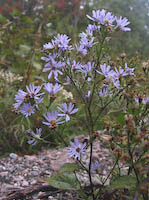Fringed Blue Aster
Symphyotrichum ciliolatum
(formerly Aster ciliolatus) |
 Other common names:
Ciliolate Aster, Lindley's Aster Other common names:
Ciliolate Aster, Lindley's Aster

Other scientific names:
Aster ciliolatus, Aster lindleyanus, Aster maccallae, Aster saundersii, Aster subgeminatus, Aster wilsoni, Aster wilsonii, Symphyotrichum subgeminatum

French names:
Aster ciliolée

Family:
Composite Family (Asteraceae)

Group:
Asters

Distinctive features:
Lower leaves look like a cross between those of Heart-leaved Aster and Arrow-leaved Aster. Flowers have long pale blue rays, and are sparsely arranged. Stem smooth. Fields.

Similar species:
•
Heart-leaved Aster (Symphyotrichum cordifolium)
•
Purple-stemmed Aster (Symphyotrichum puniceum)
•
Large-leaved Aster (Eurybia macrophylla)
•
Azure Aster (Symphyotrichum oolentangiense)
•
Arrow-leaved Aster (Symphyotrichum urophyllum)

Flowers:
Summer, Autumn; Blue/Violet; 7 or more parts (petals); 2.5-3cm in diameter. Ray flowers: 16, long, pale to deep blue. Disc flowers: 20-35, yellow becoming purple. Flowers sparse in arrangement.

Leaves:
Alternate, Simple; Sort of heart-shaped lower on the stem. Easily confused with Arrow-leaved Aster and Heart-leaved Aster. Lance-shaped and smaller higher up on stem.

Height:
Up to 1 m (1-3 ft)

Stem:
Smooth.

Habitat:
Forests, Fields and Open Areas; Open woods and meadows in poor soils. The photos on this page were taken along an old railway embank.

Grows in Sun/Shade:
Sun, Shade

Lifespan:
Perennial.

Native/Non-native:
Native

Status:
Somewhat common.

Notes:
This is a hard Aster to identify for the novice. It resembles several other Aster species. A novice might be better off leaving this species till they have more experience.

Photographs:
134 photographs available, of which 15 are featured on this page. SCROLL DOWN FOR PHOTOGRAPHS.

 |
 |
|
|
|
|
|
|
|
 |